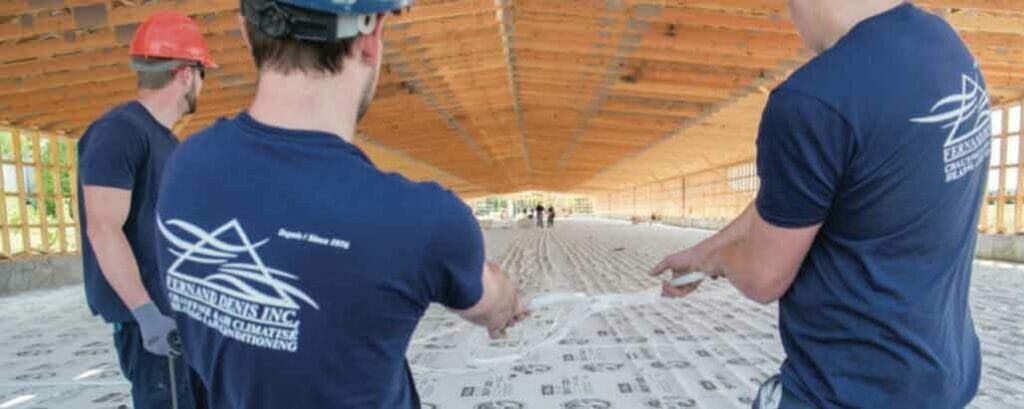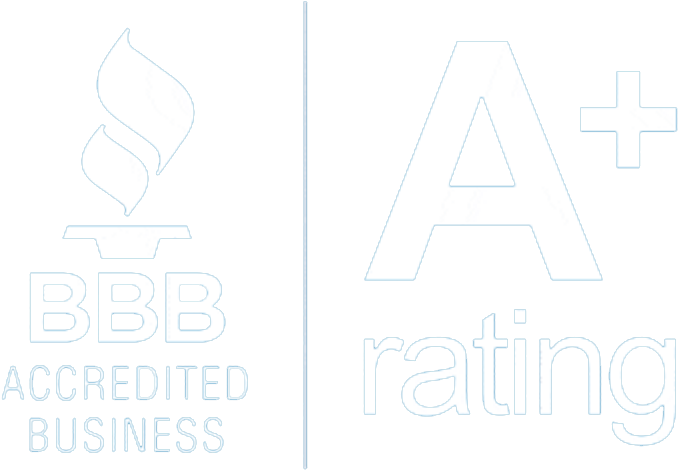RADIANT FLOOR HEATING PROJECT
Playing Chicken with PEX

Project: Russellview Chicken Farm
Location: Ottawa area
Mechanical Contractor: Fernand Denis Inc.
System Designer: Klimar Agency Inc.
General Contractor: Brian Shane Construction
Total Area: Approximately 24,287 square feet
Designed Heat Delivery: 38 BTU/sq. ft.
Loop Lengths: 400 ft. (max.)
Tubing: 5/8” PEX
Spacing: 9” on centre
Supply Water Temp: 125°F
Return Water Temp: 105°F Flow: 4 gpm
Head Loss per Mat: 14 feet
What do you do when you are installing an in-floor heating system for a poultry farmer who has already ordered the chicks that are supposed to inhabit the barn that you are still building? First step: breathe. And then you double check your dimensions and heat load requirements and go looking for heating system options that will minimize the time it takes to go from a gravel base to an installed in-floor heating system slab.
A poultry farm normally orders day-old chicks from a hatchery, raising them for approximately eight weeks before the birds are harvested for food. When Tony and Wilma Baas, the Ottawa-area farmers whose barn was being built, informed the plumbing team at Fernand Denis Inc. that their first shipment of birds would be arriving on a scheduled date, Pascal Denis knew that the building had to be ready. There was no wiggle room for him—or for the chicks.
Pascal reached out to Klimar Agency to assist in the design of the radiant heating system. Since timing would be the driving factor in the success of the project, he opted to use prefabricated radiant rollout mats of PEX, which would be enveloped in concrete to make the radiant slab. These would be part of the 1 million BTUH in-floor hydronic heating system used in the 64-by-400-foot structure.
Radiant heating systems are more common in poultry barns than forced-air heating systems, but the most common style of radiant heaters are overhead tubestyle or pancake-style “brooders,” as they are known in the poultry industry.
This particular farmer took it up a notch and opted for an in-floor radiant heating system. An in-floor radiant system has the additional advantage of even heat distribution throughout the entire floor surface, versus the hot spots that can get created directly under the traditional overhead style of heaters.
Note: This article originally appeared in Mechanical Business July/August 2016.
Consistent floor temperature in all sections of the barn leads to even distribution of the birds in the space, instead of having clusters of birds under a heater when they are cold, or bare spaces on the barn floor when an area is too hot.
Although radiant mats are somewhat more expensive than spools of PEX, the cost can be offset by the labour required to install the piping, and the fact that the mats could be installed in a small installation window made them a viable, and attractive option for this project.
As each mat is custom-built, Pascal placed his order weeks ahead of his scheduled installation date, so that they could be built to his specifications while the frame and walls of the building were going up.
Not leaving any timing to chance, Pascal actually drove to the supplier to pick up the product himself, rather than having it shipped and risk a delay from a third-party logistics company. This ensured that the tubing he needed would be on his side when he needed it – an extra step for Fernand Denis but an impressive level of customer service that showed the company’s commitment to their customer, the project and the welfare of the animals.
The use of the mats on the project helped keep the build on its tight schedule. Pascal’s crew was able to install almost 25,000 feet of tubing in a single day (see the QR code on the previous page to watch the installation video). Starting at 7 a.m., the tubing was in place and ready for the concrete pour by 1 p.m.
With the piping in place, the system was pressurized with air to approximately 80 psi to ensure no leaks were created during the concrete pour (4” slab using fibre mesh concrete) on the following morning, at which point the focus turned to commission the heating system.
With everything up and running in a couple of days, the farmer was able to fill the barn with chicks, as scheduled.









